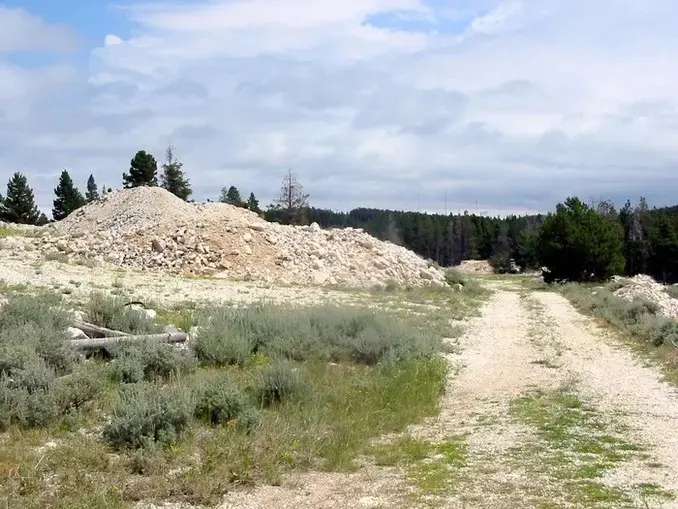Confession

- So, Picture This—I’Ve Dragged My Very Own Rock Pile From Here To My Backyard
Could that pile end up in my backyard? Well, I sure hope not. But given enough time, maybe eventually! After you dive into my adventures, you’ll be in the loop about how Wyoming rock collecting has transformed.
How
Right by my fence, there’s this rock pile, about 20 feet long, 3 feet wide, and 2 feet high. I gaze at it in awe! How did all those rocks get there? It doesn’t take long—just a 5-gallon bucket full, through the years, does it?
Have you checked out my Casper Mountain escapade? Well, I’ve revisited a few more times since then. Actually, quite a bunch.
- It’s just a short four-mile drive.
- I love collecting fluorescent minerals.
- So, I grab a five-gallon pail and head up the mountain.
- Spend an hour wandering around.
- Fill the pail with the best specimens.
- Sort them out the next day.
- Photograph the best ones.
- And put them on the pile.
It was so easy. So convenient. So much fun!
Sometimes, the same rocks I rejected and left on an earlier trip were recognized and prized during a subsequent visit. That should have been a clue.
Now, the best specimens from that outcrop are along my fence. Yep, I confess—I’m the gal that did it. And I did it one bucket at a time.
Why
Now, why did I do this? Well, I’m not entirely sure.
- Did I need them?
- Am I a compulsive gatherer?
- Am I greedy?
- Do I love to hoard?
- Am I clueless?
What
One day, my wife asked, “What are you going to do with those rocks?” I hadn’t really thought about it. But I told her I planned to sell them on eBay. Actually, that was a quick excuse. And I knew better, as that possibility conjures up unpleasant youthful memories of selling raffle tickets and fruitcakes in a small, rural town overrun with children.
Thinking about it:
- I love the hunt.
- The thrill of discovery.
- I enjoy photographing my finds.
- And sharing them with others.
But even the most spectacular rocks I collect end up sitting on a shelf for a few years. Then they’re wrapped up and put in a box, making more room for more specimens. And, wouldn’t you know it, some of those end up on the pile.
Consequences
As I stroll around my little town, I spot other rock piles like mine.
- Some contain good specimens of jade, petrified wood, chalcedony, etc.
- Some showcase the efforts of knowledgeable collectors.
- Some are used to build rock gardens, fountains, or patios.
- But most are found in long-neglected heaps, half-buried with accumulated detritus.
It’s clear that when those properties change hands, few new owners will know the value or effort those rocks reflect.
Now, what’s the value of my fluorescent rock pile to someone else? Not much, really, as those rocks, in daylight, are drab and unappealing. They would probably be sent off as trash.
This bothers me, thinking that someone might get interested in fluorescent minerals, buy a lamp, and then go prospecting. Would they find the adventure, the thrill, and the joy that I’ve found?
What if someone before me had scooped it all up?
- Would I be looking for a few drab, uninteresting specimens?
- Would my sense of value be degraded to the point where almost anything is acceptable?
- Or would any interest even exist?
If I purchased all my specimens, I’d find value and beauty, but not much thrill and certainly no sense of adventure.
Some will say that all should be got while the getting’s good. Many locations have been reclaimed, urbanized, used as road fill, or lost in other ways forever.
And that’s a good point. But are the rocks in my rock pile any more secure?
Action
Now, it’s mind-boggling that the population in the U.S. tops 300 million. Man, that’s a bunch of people. The impacts of an increased population on a fixed resource necessitate some basic changes.
It’s no longer prudent to:
- Pump all the water.
- Collect all the shells.
- Catch all the fish.
- Shoot all the game.
- Collect all the wild bees.
- Pick all the wildflowers.
- Cut all the timber one may want or is allowed to.
Sportsmen have long realized the impacts that taking can have on their sport. Many areas mandate catch-and-release programs for fishermen, and many practice it regardless.
Some hunters have replaced the gun with a camera, realizing their enjoyment isn’t based on the kill, but rather the experience itself. Taking serves no positive purpose if you don’t need it.
And if that’s the case for a renewable resource, how much more important is it for rockhounds who impact a non-renewable resource?
I have a few ideas. I’m going to limit my take.
- No more five-gallon buckets and multiple trips to the truck.
- Spend more time looking.
- Only take the few best specimens that I can carry in my hand.
I’m going to become more narrowly focused. I’ll:
- Focus on fluorescent crystal specimens, etc.
- Go looking and photographing the rest, but leave them for someone else to bag.
I’ll limit the collecting damage. If extracting an excellent specimen requires tearing up the environment or demolishing an outcrop of perfectly good specimens, I’ll take a picture and leave the rest. This is especially important on natural outcrops and imperative on public land.
When collecting in an active quarry or mine, I’ll limit damage in another way. I’ll share all I can before it goes to the crusher and photograph the rest.
Third, I’ll remember there are many ways a mineral specimen is lost. And one way:
- Involves much personal effort.
- Takes up storage space.
- Complicates moving.
- Deprives other collectors.
If it won’t be displayed, it stays where it is.
I’ll bet there’s much that I haven’t considered. What do you think?
Looking Back
That Casper Mountain pegmatite, a 100-year-old rock hounding resource, has been reclaimed and is now private property. What’s left are the memories and a few great fluorescent specimens. No more collecting there forever.
Had I known it was being reclaimed, I would have been there to collect any newly uncovered stuff during the reclamation earthwork.
I did visit the site after the earthwork was done, but before it was fenced and put up for sale. On a very dark night, as the first snow of a forecast blizzard began falling, I quickly wandered over the site, expecting to find maybe a ghost and certainly not any specimens.
What did I find? No ghosts, but several excellent fluorescent quartz specimens. The kind with the blue glow and bright green streaks. One was mostly transparent, a real keeper.
I thought about taking them home, but decided to stash them. Maybe someday, someone, knowing the area’s potential, will find those treasures and appreciate them.
Cheers, D 🪨🔥
